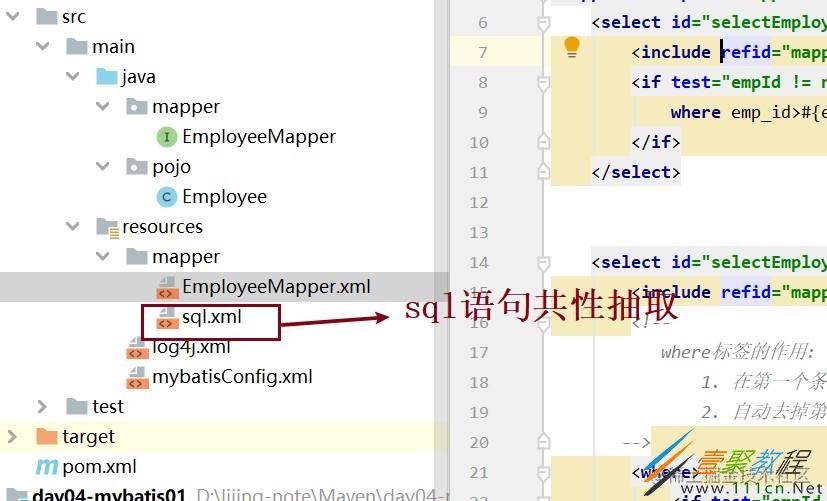MyBatis动态SQL全面代码示例解析
本篇文章小编给大家分享一下MyBatis动态SQL全面代码示例解析,文章代码介绍的很详细,小编觉得挺不错的,现在分享给大家供大家参考,有需要的小伙伴们可以来看看。
前言
前面mysql都是通过静态sql进行查询的,但是如果业务复杂的时候,我们会遇到引号问题,或者多一个空格,这就使得sql代码编写错误了,所以为了解决这个问题,我们有了动态sql。
Mybatis框架的动态SQL技术是一种根据特定条件动态拼装SQL语句的功能,它存在的意义是为了解决拼接SQL语句字符串时的痛点问题。具体是通过标签来实现的。
动态sql
1.先看一下模块目录结构
在类路径的resources下的mapper包下创建sql.xml文件(共性抽取)
2.物理建模和逻辑建模
这里省略物理建模步骤,要求数据库的表与pojo类要对应。
package pojo;
import lombok.AllArgsConstructor;
import lombok.Data;
import lombok.NoArgsConstructor;
@Data
@AllArgsConstructor
@NoArgsConstructor
public class Employee {
private Integer empId;
private String empName;
private Double empSalary;
}
3. 引入依赖
把之前的log4j复制到类路径resouces下,另外我们引入依赖后的pom.xml如下:
4.0.0 org.example day03-mybatis02-dynamic 1.0-SNAPSHOT jar org.projectlombok lombok 1.18.8 provided org.mybatis mybatis 3.5.7 junit junit 4.12 test mysql mysql-connector-java 5.1.3 runtime log4j log4j 1.2.17
4.全局配置文件
注意: 这里有驼峰映射,别名映射,路径映射和路径映射。和以前的不同的是,我们这里做了sql语句的共性抽取,所以得加一个sql的路径映射
5.sql共性抽取文件
在类路径resources下的包mapper下创建一个sql.xml(因为我们sql是要写在映射文件中,自己本身也是映射文件,所以需要写在mapper下)。到要用的时候,在映射路径文件中需要用到这个sql语句的地方加入
select emp_id,emp_name,emp_salary from t_emp
共性抽取文件也可以不配置,这时候直接在映射文件中把要执行的语句重新编写就行了。
6.mapper接口
一共有七个方法
package mapper;
import org.apache.ibatis.annotations.Param;
import pojo.Employee;
import java.util.List;
public interface EmployeeMapper {
//根据员工的empId查询大于该empId的所有员工,如果empId为null,则查询全体员工
List selectEmployeeListByEmpId(Integer empId);
/**
* 查询大于传入的empId并且工资大于传入的empSalary的员工集合,如果传入的empId为null,则不考虑empId条件
* 传入的empSalary为null则不考虑empSalary的条件
*/
List selectEmployeeListByEmpIdAndEmpSalary(@Param("empId") Integer empId, @Param("empSalary") Double empSalary);
/**
* 根据empId更新员工信息,如果某个值为null,则不更新这个字段
*/
void updateEmployee(Employee employee);
/**
* 根据emp_id查询员工信息,如果0 selectEmployeeList(Integer empId);
/**
* 添加员工信息
*/
void insertEmployee(Employee employee);
/**
* 批量添加员工集合
*/
void insertEmployeeList(@Param("employeeList") List employeeList);
/**
* 根据员工的id集合查询员工集
*/
List selectEmployeeListByEmpIdList(List idList);
}
if
目标:根据员工的empId查询大于该empId的所有员工,如果empId为null,则查询全体员工。
Dao接口的方法为:
List
静态sql:
动态sql:
where
目标:
查询大于传入的empId并且工资大于传入的empSalary的员工集合
如果传入的empId为null,则不考虑empId条件
传入的empSalary为null则不考虑empSalary的条件
Dao接口方法:
List
用if标签的动态sql:
这里可以看到,如果empSalary为空,那么sql语句为select * from t_emp where emp_id >#{empId},但是如果empId为空,那么sql语句为select * from t_emp where and emp_salary>#{empSalary},很明显这个是错的,if标签在这里就不适用了。所以我们用where标签,或者trim标签。
where和if的动态sql:
where标签的作用:
在第一个条件之前自动添加WHERE关键字
自动去掉第一个条件前的连接符(AND、OR等等)
trim
trim是修建的意思,其实就是去头去尾,这里还是根据上面那个方法
trim的动态sql
trim标签:
prefix:指定要动态添加的前缀
suffix属性:指定要动态添加的后缀
prefixOverrides:指定要动态去掉的前缀,使用“|”分隔有可能的多个值
suffixOverrides属性:指定要动态去掉的后缀,使用“|”分隔有可能的多个值
set
目标:根据empId更新员工信息,如果某个值为null,则不更新这个字段
Dao接口方法:
void updateEmployee(Employee employee);
我们先用上面的trim标签来解决一下这个问题,
trim的动态sql:
where emp_id=#{empId} emp_name=#{empName} , emp_salary=#{empSalary}
set的动态sql
update t_emp emp_name=#{empName} , emp_salary=#{empSalary}
可以看出
set标签的作用:
自动在要修改的第一个字段之前添加SET关键字
去掉要修改的第一个字段前的连接符(,)
choose、when、otherwise
目标:
根据emp_id查询员工信息,如果0
如果emp_id是大于6,那么就查询所有小于该emp_id的员工
如果是其它情况,则查询所有员工信息
Dao接口方法:
List
动态sql
choose、when、otherwise
相当于if ... elseif... elseif ... else
如果某一个when的条件成立,则不会继续判断后续的when
如果所有的when都不成立,则会拼接otherwise标签中的内容
foreach
目标1:批量添加员工信息
Dao接口方法:
void insertEmployeeList(@Param("employeeList") ListemployeeList);
1.动态sql
目标2:根据多个id查询多个员工信息
Dao接口
ListselectEmployeeListByEmpIdList(ListidList);
2.动态sql
批量查询:foreach标签
collection属性: 表示要遍历的对象,如果要遍历的参数使用@Param注解取名了就使用该名字,如果没有取名List,或者collection。
item属性: 表示遍历出来的元素,我们到时候要拼接SQL语句就得使用这个元素: 如果遍历出来的元素是POJO对象, 那么我们就通过 #{遍历出来的元素.POJO的属性} 获取数据;如果遍历出来的元素是简单类型的数据,那么我们就使用 #{遍历出来的元素} 获取这个简单类型数据
separator属性: 遍历出来的元素之间的分隔符
open属性: 在遍历出来的第一个元素之前添加前缀
close属性: 在遍历出来的最后一个元素之后添加后缀
测试程序
import mapper.EmployeeMapper;
import org.apache.ibatis.io.Resources;
import org.apache.ibatis.session.SqlSession;
import org.apache.ibatis.session.SqlSessionFactory;
import org.apache.ibatis.session.SqlSessionFactoryBuilder;
import org.junit.After;
import org.junit.Before;
import pojo.Employee;
import java.io.InputStream;
import java.util.ArrayList;
import java.util.List;
public class Test {
private EmployeeMapper employeeMapper;
private InputStream is;
private SqlSession sqlSession;
@Before
public void init() throws Exception{
//目标:获取EmployeeMapper接口的代理对象,并且使用该对象调用selectEmployee(1)方法,然后返回Employee对象
//1. 将全局配置文件转成字节输入流
is = Resources.getResourceAsStream("mybatisConfig.xml");
//2. 创建SqlSessionFactoryBuilder对象
SqlSessionFactoryBuilder sqlSessionFactoryBuilder = new SqlSessionFactoryBuilder();
//3. 使用构建者模式创建SqlSessionFactory对象
SqlSessionFactory sqlSessionFactory = sqlSessionFactoryBuilder.build(is);
//4. 使用工厂模式创建一个SqlSession对象
sqlSession = sqlSessionFactory.openSession();
//5. 使用动态代理模式,创建EmployeeMapper接口的代理对象
employeeMapper = sqlSession.getMapper(EmployeeMapper.class);
}
@After
public void after() throws Exception{
//提交事务!!!
sqlSession.commit();
//7. 关闭资源
is.close();
sqlSession.close();
}
@org.junit.Test
public void testSelectEmployeeListByEmpId(){
System.out.println(employeeMapper.selectEmployeeListByEmpId(null));
}
@org.junit.Test
public void testSelectEmployeeListByEmpIdAndEmpSalary(){
System.out.println(employeeMapper.selectEmployeeListByEmpIdAndEmpSalary(2, 300d));
}
@org.junit.Test
public void testUpdateEmployee(){
Employee employee = new Employee(3,"celia", 9000d);
employeeMapper.updateEmployee(employee);
}
@org.junit.Test
public void testSelectEmployeeList(){
System.out.println(employeeMapper.selectEmployeeList(7));
}
@org.junit.Test
public void testInsertEmployee(){
employeeMapper.insertEmployee(new Employee(null,"tom",300d));
}
@org.junit.Test
public void testInsertEmployeeList(){
List
相关文章
精彩推荐
-
 下载
下载创造与魔法九游版本
模拟经营 创造与魔法九游版本创造与魔法九游版采用了极致创新的魔幻游戏玩法感受,游戏具备最
-
 下载
下载疯狂医院达什医生中文版(Crazy Hospital)
模拟经营 疯狂医院达什医生中文版(Crazy Hospital)疯狂医院达什医生最新版是一款医院模拟经营类游戏,逼真的场景画
-
 下载
下载宝宝庄园官方版
模拟经营 宝宝庄园官方版宝宝庄园官方版是一款超级经典好玩的模拟经营类型的手游,这个游
-
 下载
下载桃源记官方正版
模拟经营 桃源记官方正版桃源记是一款休闲娱乐类的水墨手绘风格打造的模拟经营手游。玩家
-
 下载
下载长途巴士模拟器手机版
模拟经营 长途巴士模拟器手机版长途巴士模拟器汉化版是一款十分比真好玩的大巴车模拟驾驶运营类
















